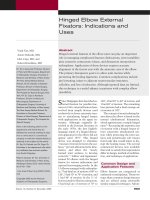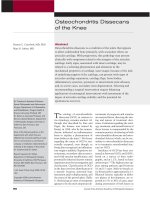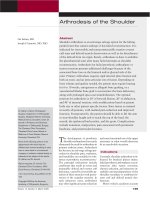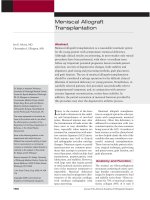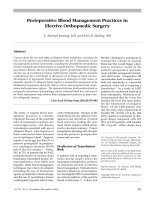Thực hành chu phẫu trong phẫu thuật chỉnh hình tự chọn pdf
Bạn đang xem bản rút gọn của tài liệu. Xem và tải ngay bản đầy đủ của tài liệu tại đây (569.62 KB, 8 trang )
Vol 10, No 6, November/December 2002
393
The safety of surgical blood man-
agement practices is critically
important because of the potential
risks of transfusion reactions, im-
munosuppression, and disease
transmission associated with use of
allogenic blood. One response to
these concerns has been increased
use of autologous blood. Approxi-
mately 15 years ago, less than 5% of
patients participated in preopera-
tive autologous donation (PAD)
before elective surgery.
1
Today,
50% to 75% of patients opt for PAD,
primarily because of concerns about
transfusion-transmitted human im-
munodeficiency virus (HIV) and
hepatitis. Other blood management
techniques have been developed,
including the use of hemostatic
agents, perioperative blood salvage,
and the use of recombinant human
erythropoietin (epoetin alfa) to stim-
ulate erythropoiesis. Because of the
implications for the effective man-
agement and allocation of blood
bank resources, making the opti-
mum choice requires careful preop-
erative decision making. Proper
preoperative planning also can opti-
mize the patient’s perioperative
course and recovery.
Predictors of Transfusion
Risk
A patient’s risk of requiring a trans-
fusion during surgery and in the
immediate postoperative period is
an important element of effective
blood management. Estimated peri-
operative blood loss and preopera-
tive hemoglobin (Hb) concentration
are critical predictors of the need for
blood transfusion.
2,3
Cohen and
Brecher
4
developed a nomogram to
estimate the volume of surgical
blood loss that would trigger a deci-
sion to transfuse, based on the
patient’s preoperative and mini-
mum tolerable postoperative hemat-
ocrit (Hct) levels. Preoperative Hb
concentration itself is readily assess-
able and statistically is a powerful
predictor of the risk of requiring a
transfusion.
5
In a study of 9,482
patients who underwent total hip or
knee arthroplasty, Bierbaum et al
6
demonstrated that the lower the
baseline Hb level, the more proba-
ble the transfusion of allogenic
blood. Of the 3,020 patients who
met the study entry requirement of
baseline Hb >10 but ≤13 g/dL, 864
(29%) needed a transfusion of allo-
genic blood compared with 267
(8%) of 3,374 patients with baseline
Hb >14 g/dL. Other studies have
Dr. Keating is Orthopaedic Surgeon, The
Center for Hip and Knee Surgery, Mooresville,
IN. Dr. Meding is Orthopaedic Surgeon, The
Center for Hip and Knee Surgery, Mooresville.
One or more of the authors or the departments
with which they are affiliated has received
something of value from a commercial or other
party related directly or indirectly to the sub-
ject of this article.
Reprint requests: Dr. Keating, 1199 Hadley
Road, Mooresville, IN 46158.
Copyright 2002 by the American Academy of
Orthopaedic Surgeons.
Abstract
Concern about the cost and safety of allogenic blood transfusion, including the
risk of viral infection and immunosuppression, has led to refinements in and
new approaches to blood conservation, including the development of transfusion
practice standards and improvements in surgical practice. Preoperative autolo-
gous blood collection, the use of hemostatic agents, perioperative blood salvage,
and the use of recombinant human erythropoietin (epoetin alfa) to stimulate
erythropoiesis have contributed to decreased use of allogenic blood services.
Development of appropriate blood management strategies to help reduce or
eliminate exposure to allogenic blood requires a preoperative assessment of the
likelihood of transfusion and of the risks as well as costs associated with conser-
vation and replacement options. The informed selection of alternatives based on
preoperative assessment of hematologic status, estimated blood loss, and sources
for blood replacement may enhance blood management practices in major elec-
tive orthopaedic surgery.
J Am Acad Orthop Surg 2002;10:393-400
Perioperative Blood Management Practices in
Elective Orthopaedic Surgery
E. Michael Keating, MD, and John B. Meding, MD
shown that surgical morbidity and
mortality are inversely correlated
with preoperative Hb levels.
3,7
Although the transfusion thresh-
old of Hb 10 g/dL and Hct 30% (the
10/30 rule) is no longer common
practice, using lower transfusion
thresholds has not resulted in deter-
mination of an optimal threshold
for all patients.
8
Instead, the deci-
sion for blood transfusion should be
based on a patient’s overall clinical
status and the nature of the anemia
(eg, acute or chronic) once other
measures of red blood cell repletion
have failed.
9,10
Effect of Anemia on
Surgical Outcomes
The primary purpose of transfusion
is to reduce the risks associated with
anemia, which is common in pa-
tients undergoing elective ortho-
paedic surgery. Of the 8,561 pa-
tients in the Bierbaum study
6
for
whom the baseline Hb level was
known, 35% (3,020) had a level ≤13
g/dL. Furthermore, the mean Hb
level decreased from a mean base-
line value of 13.8 to 12.8 g/dL before
admission in patients who predonat-
ed blood. In another study
11
assess-
ing the prevalence of anemia in elec-
tive orthopaedic surgery patients, 34
(21%) of 162 patients who predonat-
ed autologous blood were anemic
(Hct ≤39%) at initial donation. Sub-
sequently, 35% of these anemic
donors required allogenic blood
transfusion, indicating a need for
early identification and treatment of
anemia. Furthermore, the incidence
of anemia by numeric criteria in
elderly patients (≥65 years) is four to
six times greater than can be predict-
ed by the presence of clinical symp-
toms.
12
The incidence of anemia
increases with age
12
and is of partic-
ular concern because the elderly
constitute a large proportion of pa-
tients undergoing elective ortho-
paedic surgery.
Morbidity and Mortality
Anemia has an adverse effect on
morbidity and mortality. Morbidi-
ties associated with both acute and
chronic severe anemia (Hb <6 g/dL),
especially in older patients, include
fatigue, tachycardia, hypotension,
dyspnea, and impaired levels of
consciousness.
13,14
Anemia and the
associated need for transfusion also
can lengthen the duration of hospi-
talization after elective orthopaedic
surgery. In the Bierbaum study,
6
patients who received a transfusion
of only allogenic blood had the
longest mean duration of hospital-
ization (6.6 days), compared with
patients who were transfused with
autologous blood (5.6 days) or had
no transfusion (5.4 days) (P ≤ 0.01).
Severe preoperative anemia is
associated with an increased risk of
postoperative mortality. Carson et al
8
reported that the 30-day mortality
rate in cardiovascular patients with
preoperative Hb levels <6 g/dL was
33.3% compared with 1.3% for those
with levels ≥12 g/dL. (The patients
with low Hb levels refused transfu-
sion because of religious convic-
tions.) In an earlier study,
7
a higher
surgical mortality rate was reported
for patients with Hb levels <6 g/dL
(61.5%) compared with those with
levels >10 g/dL (7.1%).
Patient Vigor and Quality of Life
Another potential complication
of anemia is decreased vigor, which
can have implications for recovery,
prolonging length of hospitalization
and affecting quality of life. Early
inpatient rehabilitation after surgery
decreases the length and cost of
hospitalization and enhances short-
term functional recovery.
15
Assess-
ments of the patient’s preoperative
and postoperative vigor could,
therefore, play an important role in
initiating and monitoring the early
rehabilitation program.
A correlation (r = 0.4) between
muscle strength (a surrogate mea-
sure of vigor) and Hct levels sug-
gests that Hct may be a valuable
objective measure of vigor in pa-
tients undergoing major elective or-
thopaedic surgery.
16
Furthermore,
improving vigor in this population
by increasing Hb and Hct levels
could facilitate recovery and im-
prove overall quality of life. Studies
assessing the effect of increases in
Hb on quality of life after adminis-
tration of epoetin alfa in anemic
cancer patients demonstrated a
direct correlation between Hb level
and quality of life.
17,18
The largest
improvement in quality of life in
these patients occurred when Hb
levels were increased from 11 to 12
g/dL.
17
However, a similar correla-
tion between increases in Hb and
improved quality of life in ortho-
paedic surgery patients remains to
be established.
Perioperative Blood
Management
Allogenic Blood Transfusion
Historically, allogenic blood
transfusion has been the mainstay
in perioperative blood manage-
ment. However, the association of
allogenic blood transfusions with
numerous risks—including trans-
mission of HIV, hepatitis B and C
viruses, and human T-cell lym-
photropic virus types I and II—has
diminished its utility
19,20
(Table 1).
The institution of various measures
to improve the detection and elimi-
nation of tainted blood supplies has
substantially reduced the estimated
risks of transfusion-transmitted dis-
eases.
21
The implementation of HIV-
antibody testing in 1985 reduced the
rate of transfusion-associated HIV
infection reported to the Centers for
Disease Control and Prevention
from 714 cases in 1984 to only about
5 cases per year during the subse-
quent 5 years.
21
Similarly, screening
tests for hepatitis B and C viruses
also have decreased the number of
cases of posttransfusion hepatitis.
21
Blood Management in Elective Orthopaedic Surgery
Journal of the American Academy of Orthopaedic Surgeons
394
Nevertheless, the risk of infection
or other adverse reactions still
exists. Observational retrospective
reports
22
and prospective studies
23
both have described an association
between exposure to allogenic
blood and increased rates of postop-
erative infection and early recur-
rence of cancer. Although exposure
to leukocytes in allogenic blood and
subsequent sensitization can trigger
an immunosuppressive reaction, the
clinical importance of this immuno-
suppression has yet to be clearly
defined.
21
Other risks include bac-
terial contamination and transfu-
sion-related acute lung injury.
Finally, despite advances in the
understanding of red blood cell
antigens, allogenic transfusions are
known to cause fatal acute hemolytic
reaction (albeit rarely).
Directed donation of allogenic
blood increased in the early 1990s,
presumably because the practice
allayed the fears of some patients of
contracting disease from unknown
donors. Nevertheless, directed
donations accounted for only 2% to
3% of all blood collected between
1989 and 1994 in the United States
and have since declined.
1
Although
the use of blood from directed do-
nations potentially can accelerate
surgery compared with the time
required for donation of autologous
blood or for epoetin alfa therapy, no
evidence suggests that directed
donations lessen the risks associated
with allogenic blood transfusion.
Preoperative Autologous Blood
Donation
The use of PAD has increased sub-
stantially in recent years although it
has been associated with such risks
as preoperative anemia, ischemic
events, and complications severe
enough to require hospitalization.
24-27
Furthermore, the magnitude and rate
of patient response to compensatory
erythropoiesis to replace donated red
blood cells generally has been overes-
timated.
1
In one study,
27
preopera-
tive donation between 42 and 7 days
before surgery still resulted in an
average decrease of 1 g/dL for every
unit of autologous blood donated,
suggesting an absence of adequate
compensatory erythropoiesis. Au-
thors of a recent study of 225 adults
estimated that compensatory eryth-
ropoiesis resulted in preoperative
mean red blood cell production of
351 mL compared with a mean loss
of 522 mL from weekly donations of
autologous blood.
28
In another study
of patients undergoing aggressive
autologous blood phlebotomy, the
administration of erythropoietin
increased preoperative red blood cell
production from 568 mL (placebo
group) to 911 mL.
29
Adequate iron
supplementation is important for
patients with low iron stores while
they undergo erythropoietin treat-
ment.
30
The degree of compensatory
erythropoiesis depends on initial iron
status but not on patient age and
sex.
31
Overcollection of blood also is a
problem associated with PAD. As
much as 50% of autologous blood is
unused in patients undergoing joint
replacement or radical prostatec-
tomy.
1
PAD is often used to cover
the need for a range (up to 90%) of
patients who might need blood, a
practice that results in the routine
collection of more blood than is
needed for the average patient.
(Some patients who have blood col-
lected do not require it; other pa-
tients have more blood collected
than is needed.) Other reasons for
the possible overuse of PAD include
perceptions that PAD is associated
with no or few adverse events, pa-
tients’ fears of contracting transfu-
sion-transmitted diseases, and po-
tential legal issues associated with
allogenic blood transfusions.
In addition to weighing the risks
of anemia and the cost of medical
resources associated with overcollec-
tion, clinicians considering PAD for
elective surgeries should review
published guidelines for the appro-
E. Michael Keating, MD, and John B. Meding, MD
Vol 10, No 6, November/December 2002
395
Table 1
Estimated Risks of Allogenic Blood Transfusion
19,20,22,23
Risk Frequency of Occurrence per
Unit of Blood Transfused
Viral infection
HIV 1:1,000,000
HBV 1:100,000
HCV 1:500 to 1:5,000
HTLV I and II 1:200,000
CMV and bacterial contamination Varies; 1:2,500
Immunosuppression
Infection Increased after surgery
Cancer Inconclusive
Transfusion reaction
Fatal hemolytic reaction <1:600,000
Nonfatal hemolytic reaction 1:6,000
Fever or urticaria 1:100
Allergic reaction 1:100
Graft-versus-host disease Rare
Alloimmunization Common
HIV = human immunodeficiency virus; HBV = hepatitis B virus; HCV = hepatitis C
virus; HTLV = human T-cell lymphotropic virus; CMV = cytomegalovirus.
priate use of PAD.
32
Patients should
be stratified according to risk of
requiring a transfusion. This stratifi-
cation is based on preoperative Hb
levels and the estimated blood loss
associated with the scheduled proce-
dure. As mentioned, preoperative
Hb levels are a practical means of
estimating the risk of requiring a
transfusion.
5
However, algorithms
that determine low and high risk for
transfusion based on estimated
blood loss and preoperative Hct
level may have limited usefulness
because of the difficulty in predict-
ing actual blood loss for a given pro-
cedure and patient. According to
the British consensus guidelines,
32
PAD should be considered only if
the likelihood of transfusion exceeds
50%. In the United States, this per-
centage is much lower because laws
in some states require that the possi-
bility of autologous transfusion be
presented to patients even though
the likelihood of transfusion is low.
Patients being considered for PAD
should receive supplemental oral
iron therapy (eg, 325 mg ferrous sul-
fate 3 times a day). Autologous
blood donation generally should
begin 3 to 5 weeks before the sched-
uled surgery.
PAD allows patients to fulfill
blood requirements for planned sur-
gical procedures with minimal risk
of transfusion-transmitted diseases.
Predominantly the risk is that of
clerical error, similar to that of allo-
genic transfusion. In addition, PAD
is sometimes wasteful and should
be used only in the context of care-
ful preoperative planning.
Acute Normovolemic
Hemodilution
Acute normovolemic hemodilu-
tion (ANH) involves simultaneous
removal of whole blood from a
patient immediately before begin-
ning surgery and replacement with
acellular fluids, such as crystalloid
and colloid, to maintain normovol-
emia.
1
The blood is collected in an
anticoagulant-containing bag and
stored in the operating room, to be
reinfused after any major loss of
blood. Guidelines for ANH recom-
mend that this approach be consid-
ered when the potential surgical
blood loss is likely to exceed 20% of
blood volume in patients with a
preoperative Hb level >10 g/dL.
1
In contrast with PAD, ANH does
not require testing to screen for
transfusion-transmitted viral dis-
eases and therefore is less costly.
Furthermore, there is virtually no
risk of bacterial contamination or of
an administrative error that could
lead to an ABO-incompatible blood
transfusion. ANH also does not
require the additional investment of
time from patients to donate blood
before surgery, nor does it prolong
the duration of surgery and anes-
thesia.
33
However, ANH is con-
traindicated in patients with coro-
nary artery, renal, pulmonary, or
severe hepatic disease.
10
Also,
because the precision required to
implement the technique is time
consuming, the use of ANH is often
impractical in many orthopaedic
procedures of short duration.
10
Epoetin Alfa
The main regulator for erythro-
poiesis is erythropoietin, a glycopro-
tein hormone synthesized predomi-
nantly in the kidney and secreted by
renal cortical interstitial cells in
response to tissue hypoxia. Erythro-
poietin functions in the recruitment
and differentiation of erythroid
progenitor cells, aids in their mainte-
nance and survival, and stimulates
the synthesis of Hb. Epoetin alfa is
identical to endogenous erythropoi-
etin in its amino acid sequence and
biologic activity. Like endogenous
erythropoietin, epoetin alfa effec-
tively and safely stimulates synthe-
sis of Hb and thus has clinical value
in the treatment of anemia. Epoetin
alfa has been available for more than
10 years and has been used to treat
anemia in patients with chronic
renal failure, in patients with non-
myeloid malignancies (in which
anemia results from concomitantly
administered chemotherapy), and in
HIV-infected patients with anemia
related to treatment with zidovu-
dine. Epoetin alfa also has been
used preoperatively in patients
undergoing elective noncardiac,
nonvascular surgery. Research is
ongoing in other patient popula-
tions, including critical care patients.
Although epoetin alfa can be
administered both intravenously
and subcutaneously, subcutaneous
administration generally is pre-
ferred because slow release from
subcutaneous depots provides more
sustained plasma levels.
34
For sur-
gical patients, these sustained plas-
ma levels allow for weekly dosing
of epoetin alfa. Adequate iron sta-
tus must be maintained through
supplementation in patients receiv-
ing epoetin alfa.
35
Epoetin alfa is useful in the peri-
operative treatment of anemia in
patients undergoing elective, non-
cardiac, nonvascular surgery.
36
Studies in anemic (Hb ≥10 to ≤13
g/dL) patients undergoing elective
orthopaedic surgery have shown
that treatment with epoetin alfa (300
IU/kg/day for 15 days periopera-
tively, or 600 IU/kg in four weekly
doses beginning 3 weeks before
surgery) increases preoperative Hb
concentrations and reduces the need
for perioperative allogenic blood
transfusions.
37-40
Figure 1 is a treat-
ment algorithm for the use of epoetin
alfa in anemic patients. Normal pa-
tients with Hb <10 g/dL should be
worked up by a hematologist. Pa-
tients with a chronic disease such as
rheumatoid arthritis and Hb <10
g/dL should receive epoetin alfa for
a longer duration.
No significant safety issues have
been noted in studies of epoetin alfa
in surgical patients. Incidence of
thrombotic/vascular events, blood
pressure changes, pain, bruising,
and stinging at the injection site did
Blood Management in Elective Orthopaedic Surgery
Journal of the American Academy of Orthopaedic Surgeons
396
not differ significantly from those of
placebo groups.
37,38
Intraoperative Blood
Management
Optimal intraoperative blood man-
agement reduces the need for allo-
genic blood transfusion through
modifications in surgical technique,
use of hemostatic agents, and blood
salvage strategies. Approximately
two thirds of transfusions in the
United States are related to surgical
procedures;
10
orthopaedic surgeons,
therefore, should be aware of the
blood conservation strategies as
well as the relevant pharmaceutical
agents available (Fig. 2).
Surgical Technique
Blood loss can be minimized
through careful adherence to pre-
scribed guidelines for maintaining
hemostasis.
41
Techniques such as
electrocautery and argon-beam
coagulation can reduce blood loss
safely and effectively. Hypotensive
anesthesia is an effective option for
blood management for procedures
such as spine surgery and arthro-
plasty. In patients undergoing pri-
mary total hip arthroplasty, a differ-
ence in mean arterial blood pressure
of 10 mm Hg (from 60 to 50 mm Hg)
significantly (P = 0.004) reduced
mean intraoperative blood loss from
263 to 179 mL.
42
In addition, an
arterial line is necessary for this
technique.
Hemostatic Agents
Pharmacologic agents available
or under investigation for mainte-
nance of perioperative hemostasis
include topically active agents and
antifibrinolytics.
10
Topically or
locally active agents include throm-
bin, collagen, and fibrin glue. A
proprietary gelatin matrix contain-
ing thrombin was shown to stop
bleeding in cardiac surgery within
10 minutes in 94% of patients.
43
Collagen-based topical hemostatic
agents also controlled bleeding.
Fibrin glue, made with highly con-
centrated human fibrinogen and
clotting factors, does not depend on
platelet or clotting factor levels to be
effective. The use of a fibrin tissue
adhesive significantly (P < 0.001)
reduced mean postoperative blood
loss from 878 to 360 mL in a study
of 58 patients undergoing total knee
arthroplasty.
44
The fibrin tissue
adhesive was sprayed on the inter-
nal aspects of the operating field
before skin closure.
Although the use of antifibri-
nolytic drugs to maintain periopera-
tive hemostasis has increased, they
remain controversial because of high
cost and the risk of thromboembolic
complications.
45
Desmopressin has
been widely used to prevent bleed-
ing in other types of surgery,
46
but
several studies have shown that it
failed to decrease blood loss or
E. Michael Keating, MD, and John B. Meding, MD
Vol 10, No 6, November/December 2002
397
Pretreatment Hb
≤10 or >13 g/dL>10 to ≤13 g/dL
Not a candidate for
epoetin alfa therapy
If the preoperative
period is <3 wk,
treat with epoetin alfa
20,000 U* (300 U/kg)
10 d preoperatively, on
the day of surgery, and
4 d postoperatively
If the preoperative
period is ≥3 wk,
treat with epoetin alfa
40,000 U* (600 U/kg)
on days −21, −14,
and −7, and the day
of surgery
Figure 1 Treatment algorithm for use of
epoetin alfa in anemic patients scheduled
for elective, noncardiac, nonvascular sur-
gery at high risk for transfusion because of
anticipated blood loss.
* Based on patient weight of 70 kg.
Decision for orthopaedic surgery
Measure Hb
>10 to ≤13 g/dL*
Predict Hb drop
Transfusion risk <10% Transfusion risk ≥10%
Surgery Surgery
Surgery
Surgery
Donate
autologous blood
Treat anemia with oral
iron supplementation
and epoetin alfa
Transfusion risk <10% Transfusion risk ≥10%
>13 g/dL
Predict Hb drop
Figure 2 Algorithm for optimizing blood management strategies in orthopaedic surgery.
Average Hb drop: single total knee replacement, 3.85 ± 1.4 g/dL; bilateral total knee
replacement, 5.42 ± 1.8 g/dL; single total hip replacement, 4.07 ± 1.74 g/dL.
* Normal patients with Hb <10 g/dL should be worked up by a hematologist.
transfusion requirements in patients
undergoing total hip or knee arthro-
plasty.
47,48
Aprotinin has had mixed
results. In one study
49
of 40 patients
who underwent total hip arthroplas-
ty, those given aprotonin showed a
significant (P < 0.05) reduction in
blood loss from 1,943 to 1,446 mL
and a decrease in mean blood trans-
fusions from 3.4 to 1.8 units. Another
study
50
of aprotonin showed no
effect on blood loss or transfusion
requirement. Tranexamic acid has
been shown to reduce both postop-
erative blood loss and transfusion
requirements in patients undergoing
total knee arthroplasty.
51,52
Blood Salvage
Despite advances in surgical
technique and the effective use of
hemostatic agents, blood loss dur-
ing orthopaedic procedures can be
extensive. Blood salvage returns to
the patient washed or unwashed
autologous blood lost in surgery.
The blood is collected by aspiration
or drainage, filtered, and centri-
fuged before transfusion.
10
Blood
salvage can be applied both intraop-
eratively and postoperatively.
Intraoperative Blood Recovery
Intraoperative recovery of autolo-
gous blood requires special equip-
ment and trained personnel. Cell-
washing devices can provide the
equivalent of 10 units of banked
blood per hour.
1
However, because
cell-washing does not completely
remove bacteria from recovered
blood, this technique should not be
used if the surgical field has gross
bacterial contamination.
53
Other
contraindications for intraoperative
blood recovery include the potential
for aspiration of malignant cells, the
presence of infection, or the presence
of contaminants such as amniotic or
ascitic fluid.
1
Deaths related to
intraoperative blood recovery have
been reported; estimated risk is 1 per
35,000 procedures. Interestingly,
studies of patients undergoing either
cardiothoracic surgery
54
or repair
of abdominal aortic aneurysms
55
showed that intraoperative blood
recovery did not result in fewer
blood transfusions. However, intra-
operative recovery still may be of
value in patients with substantial
blood loss during major ortho-
paedic surgery because it provides
less costly, immediately available
blood.
1
At least 2 units need to be
recovered for the method to be cost
effective.
1
Postoperative Blood Recovery
Postoperative recovery involves
collecting blood from surgical drains
followed by reinfusion, with or with-
out processing. Because the recov-
ered blood is diluted, defibrinated,
and partially hemolyzed, and is likely
to contain cytokines, there is gener-
ally a threshold for the volume of
unprocessed blood that can be rein-
fused. This technique has been
used most commonly after cardiac
surgery.
1
The value of postoperative
blood recovery in these patients is
controversial; some studies demon-
strate a benefit,
56
while others show
no efficacy.
57
The safety and useful-
ness of postoperative blood recovery
after orthopaedic surgery also re-
mains controversial.
58,59
Because of
the high cost and questionable bene-
fit of this technique, postoperative
blood recovery should be limited to
cases in which large postoperative
blood losses are anticipated, such as
in bilateral joint replacement sur-
gery.
1
Summary
Concern about the safety of allo-
genic blood transfusion has led to
notable refinements and new ap-
proaches to blood conservation.
10
These efforts include the develop-
ment of transfusion practice stan-
dards, promotion of PAD, the clini-
cal use of epoetin alfa to stimulate
erythropoiesis, improvements in
surgical practice, the use of hemo-
static agents, and perioperative
blood salvage. Despite these ad-
vances, awareness must be raised
regarding the significance of preop-
erative Hb levels in predicting and
reducing transfusion requirements
in major orthopaedic surgery. A
strategy for managing perioperative
blood loss can minimize or elimi-
nate the need for allogenic blood.
The preoperative assessment of
estimated blood loss and transfu-
sion risk, and careful evaluation of
alternative sources for replacement
of blood, are key to optimizing
blood management strategies. Sur-
geons must be discriminating in
their use of PAD, blood salvage,
and epoetin alfa by carefully consid-
ering the clinical status of individ-
ual patients, specific surgical pro-
cedures, potential adverse effects,
and outcomes.
Blood Management in Elective Orthopaedic Surgery
Journal of the American Academy of Orthopaedic Surgeons
398
References
1. Goodnough LT, Brecher ME, Kanter
MH, AuBuchon JP: Transfusion medi-
cine: Second of two parts. Blood conser-
vation. N Engl J Med 1999;340:525-533.
2. Nuttall GA, Santrach PJ, Oliver WC Jr,
et al: The predictors of red cell transfu-
sions in total hip arthroplasties. Trans-
fusion 1996;36:144-149.
3. Spence RK, Cernaianu AC, Carson J,
DelRossi AJ: Transfusion and surgery.
Curr Probl Surg 1993;30:1101-1180.
4. Cohen JA, Brecher ME: Preoperative
autologous blood donation: Benefit or
detriment? A mathematical analysis.
Transfusion 1995;35:640-644.
5. Stowell CP, Faris P, Laupacis A, Samp-
son AR, Larholt K, Frei D: Abstract:
The predictive power of preoperative
hemoglobin (Hb) for transfusion risk in
orthopedic surgery. Transfusion 1996;36
(suppl 29):113.
6. Bierbaum BE, Callaghan JJ, Galante
JO, Rubash HE, Tooms RE, Welch RB:
An analysis of blood management in
patients having a total hip or knee
arthroplasty. J Bone Joint Surg Am
1999;81:2-10.
7. Carson JL, Poses RM, Spence RK,
Bonavita G: Severity of anaemia and
operative mortality and morbidity.
Lancet 1988;1:727-729.
8. Carson JL, Duff A, Poses RM, et al:
Effect of anaemia and cardiovascular
disease on surgical mortality and mor-
bidity. Lancet 1996;348:1055-1060.
9. American College of Physicians:
Practice strategies for elective red blood
cell transfusion. Ann Intern Med 1992;
116:403-406.
10. Keating EM: Current options and
approaches for blood management in
orthopaedic surgery. Instr Course Lect
1999;48:655-665.
11. Goodnough LT, Vizmeg K, Sobecks R,
Schwarz A, Soegiarso W: Prevalence
and classification of anemia in elective
orthopedic surgery patients: Implica-
tions for blood conservation programs.
Vox Sang 1992;63:90-95.
12. Ania BJ, Suman VJ, Fairbanks VF,
Rademacher DM, Melton LJ III: Inci-
dence of anemia in older people: An
epidemiologic study in a well defined
population. J Am Geriatr Soc 1997;45:
825-831.
13. Spence RK: Anemia in the patient un-
dergoing surgery and the transfusion
decision: A review. Clin Orthop 1998;
357:19-29.
14. Lands L: Breathlessness. POZ March
1999:54-56.
15. Munin MC, Rudy TE, Glynn NW,
Crossett LS, Rubash HE: Early inpa-
tient rehabilitation after elective hip and
knee arthroplasty. JAMA 1998;279:
847-852.
16. Keating EM, Ranawat CS, Cats-Baril
W: Assessment of postoperative vigor
in patients undergoing elective total
joint arthroplasty: A concise patient-
and caregiver-based instrument.
Orthopedics 1999;22(suppl 1):119-128.
17. Cleeland CS, Demetri GD, Glaspy J, et
al: Abstract: Identifying hemoglobin
level for optimal quality of life: Results
of an incremental analysis. Proc Am
Soc Clin Oncol 1999;18:574a.
18. Gabrilove JL, Einhorn LH, Livingston
RB, Winer E, Cleeland CS: Abstract:
Once-weekly dosing of epoetin alfa is
similar to three-times-weekly dosing
in increasing hemoglobin and quality
of life. Proc Am Soc Clin Oncol 1999;
18:574a.
19. Klein HG: Allogeneic transfusion
risks in the surgical patient. Am J Surg
1995;170(suppl 6A):21S-26S.
20. Klein HG: Editorial: Transfusion safe-
ty. Avoiding unnecessary bloodshed.
Mayo Clin Proc 2000;75:5-7.
21. Goodnough LT, Brecher ME, Kanter
MH, AuBuchon JP: Transfusion medi-
cine: First of two parts. Blood transfu-
sion. N Engl J Med 1999;340:438-447.
22. Bordin JO, Heddle NM, Blajchman
MA: Biologic effects of leukocytes
present in transfused cellular blood
products. Blood 1994;84:1703-1721.
23. Vamvakas EC: Transfusion-associated
cancer recurrence and postoperative
infection: Meta-analysis of randomized,
controlled clinical trials. Transfusion
1996;36:175-186.
24. Popovsky MA, Whitaker B, Arnold NL:
Severe outcomes of allogeneic and
autologous blood donation: Frequency
and characterization. Transfusion 1995;
35:734-737.
25. Goodnough LT, Monk TG: Evolving
concepts in autologous blood procure-
ment and transfusion: Case reports of
perisurgical anemia complicated by
myocardial infarction. Am J Med 1996;
101:33S-37S.
26. Kasper SM, Ellering J, Stachwitz P,
Lynch J, Grunenberg R, Buzello W:
All adverse events in autologous
blood donors with cardiac disease are
not necessarily caused by blood dona-
tion. Transfusion 1998;38:669-673.
27. Kanter MH, van Maanen D, Anders
KH, Castro F, Mya WW, Clark K: Pre-
operative autologous blood donations
before elective hysterectomy. JAMA
1996;276:798-801.
28. Kasper SM, Gerlich W, Buzello W: Pre-
operative red cell production in patients
undergoing weekly autologous blood
donation. Transfusion 1997;37:1058-1062.
29. Goodnough LT, Price TH, Rudnick S,
Soegiarso RW: Preoperative red cell
production in patients undergoing
aggressive autologous blood phleboto-
my with and without erythropoietin
therapy. Transfusion 1992;32:441-445.
30. Mercuriali F, Zanella A, Barosi G, et al:
Use of erythropoietin to increase the
volume of autologous blood donated
by orthopedic patients. Transfusion
1993;33:55-60.
31. Goodnough LT, Price TH, Parvin CA:
The endogenous erythropoietin re-
sponse and the erythropoietic response
to blood loss anemia: The effects of
age and gender. J Lab Clin Med 1995;
126:57-64.
32. Thomas MJ, Gillon J, Desmond MJ:
Consensus conference on autologous
transfusion: Preoperative autologous
donation. Transfusion 1996;36:633-639.
33. Monk TG, Goodnough LT, Birkmeyer
JD, Brecher ME, Catalona WJ: Acute
normovolemic hemodilution is a cost-
effective alternative to preoperative
autologous blood donation by patients
undergoing radical retropubic prosta-
tectomy. Transfusion 1995;35:559-565.
34. Erslev AJ: Erythropoietin. N Engl J Med
1991;324:1339-1344.
35. Adamson JW: The relationship of eryth-
ropoietin and iron metabolism to red
blood cell production in humans.
Semin Oncol 1994;21(suppl 2):9-15.
36. Faris PM, Ritter MA: Epoetin alfa: A
bloodless approach for the treatment
of perioperative anemia. Clin Orthop
1998;357:60-67.
37. Faris PM, Ritter MA, Abels RI: The
effects of recombinant human erythro-
poietin on perioperative transfusion
requirements in patients having a
major orthopaedic operation: The
American Erythropoietin Study Group.
J Bone Joint Surg Am 1996;78:62-72.
38. de Andrade JR, Jove M, Landon G,
Frei D, Guilfoyle M, Young DC:
Baseline hemoglobin as a predictor of
risk of transfusion and response to
Epoetin alfa in orthopedic surgery
patients. Am J Orthop 1996;25:533-542.
39. Canadian Orthopedic Perioperative
Erythropoietin Study Group: Effective-
ness of perioperative recombinant
human erythropoietin in elective hip
replacement. Lancet 1993;341:1227-
1232.
40. Goldberg MA, McCutchen JW, Jove M,
et al: A safety and efficacy comparison
study of two dosing regimens of epoe-
tin alfa in patients undergoing major
orthopedic surgery. Am J Orthop
1996;25:544-552.
41. Spence RK: Surgical red blood cell
transfusion practice policies: Blood
Management Practice Guidelines
Conference. Am J Surg 1995;170(suppl
6A):3-15.
42. Sharrock NE, Mineo R, Urquhart B,
Salvati EA: The effect of two levels of
hypotension on intraoperative blood
loss during total hip arthroplasty per-
formed under lumbar epidural anes-
thesia. Anesth Analg 1993;76:580-584.
43. Oz MC, Cosgrove DM III, Badduke BR,
et al: Controlled clinical trial of a novel
hemostatic agent in cardiac surgery:
The Fusion Matrix Study Group. Ann
Thorac Surg 2000;69:1376-1382.
44. Levy O, Martinowitz U, Oran A, Tauber
C, Horoszowski H: The use of fibrin tis-
E. Michael Keating, MD, and John B. Meding, MD
Vol 10, No 6, November/December 2002
399
sue adhesive to reduce blood loss and
the need for blood transfusion after
total knee arthroplasty: A prospective,
randomized, multicenter study. J Bone
Joint Surg Am 1999;81:1580-1588.
45. Slaughter TF, Greenberg CS: Anti-
fibrinolytic drugs and perioperative
hemostasis. Am J Hematol 1997;56:32-36.
46. Graham ID, Fergusson D, McAuley L,
Laupacis A: The use of technologies to
minimize exposure to perioperative
allogeneic blood transfusion in elective
surgery: A survey of Canadian hospi-
tals. Int J Technol Assess Health Care
2000;16:228-241.
47. Karnezis TA, Stulberg SD, Wixson RL,
Reilly P: The hemostatic effects of
desmopressin on patients who had
total joint arthroplasty: A double-blind
randomized trial. J Bone Joint Surg Am
1994;76:1545-1550.
48. Schott U, Sollen C, Axelsson K, Rugarn
P, Allvin I: Desmopressin acetate does
not reduce blood loss during total hip
replacement in patients receiving dex-
tran. Acta Anaesthesiol Scand 1995;39:
592-598.
49. Janssens M, Joris J, David JL, Lemaire
R, Lamy M: High-dose aprotinin
reduces blood loss in patients under-
going total hip replacement surgery.
Anesthesiology 1994;80:23-29.
50. Hayes A, Murphy DB, McCarroll M:
The efficacy of single-dose aprotinin 2
million KIU in reducing blood loss
and its impact on the incidence of
deep venous thrombosis in patients
undergoing total hip replacement
surgery. J Clin Anesth 1996;8:357-360.
51. Hiippala ST, Strid LJ, Wennerstrand
MI, et al: Tranexamic acid radically
decreases blood loss and transfusions
associated with total knee arthroplas-
ty. Anesth Analg 1997;84:839-844.
52. Benoni G, Carlsson A, Petersson C,
Fredin H: Does tranexamic acid reduce
blood loss in knee arthroplasty? Am
J Knee Surg 1995;8:88-92.
53. Napier JA, Bruce M, Chapman J, et al:
Guidelines for autologous transfusion:
Part II. Perioperative haemodilution and
cell salvage. British Committee for
Standards in Haematology Blood Trans-
fusion Task Force: Autologous Transfu-
sion Working Party. Br J Anaesth 1997;
78:768-771.
54. Bell K, Stott K, Sinclair CJ, Walker WS,
Gillon J: A controlled trial of intra-
operative autologous transfusion in
cardiothoracic surgery measuring
effect on transfusion requirements and
clinical outcome. Transfus Med 1992;2:
295-300.
55. Clagett GP, Valentine RJ, Jackson MR,
Mathison C, Kakish HB, Bengtson TD:
A randomized trial of intraoperative
autotransfusion during aortic surgery.
J Vasc Surg 1999;29:22-31.
56. Eng J, Kay PH, Murday AJ, et al:
Postoperative autologous transfusion
in cardiac surgery: A prospective, ran-
domised study. Eur J Cardiothorac Surg
1990;4:595-600.
57. Ward HB, Smith RR, Landis KP,
Nemzek TG, Dalmasso AP, Swaim
WR: Prospective, randomized trial of
autotransfusion after routine cardiac
operations. Ann Thorac Surg 1993;56:
137-141.
58. Faris PM, Ritter MA, Keating EM,
Valeri CR: Unwashed filtered shed
blood collected after knee and hip
arthroplasties: A source of autologous
red blood cells. J Bone Joint Surg Am
1991;73:1169-1178.
59. Ritter MA, Keating EM, Faris PM:
Closed wound drainage in total hip or
total knee replacement: A prospective,
randomized study. J Bone Joint Surg
Am 1994;76:35-38.
Blood Management in Elective Orthopaedic Surgery
Journal of the American Academy of Orthopaedic Surgeons
400


